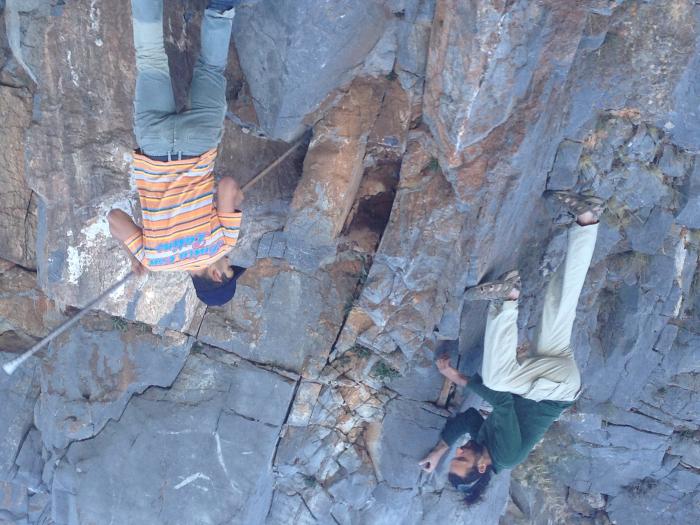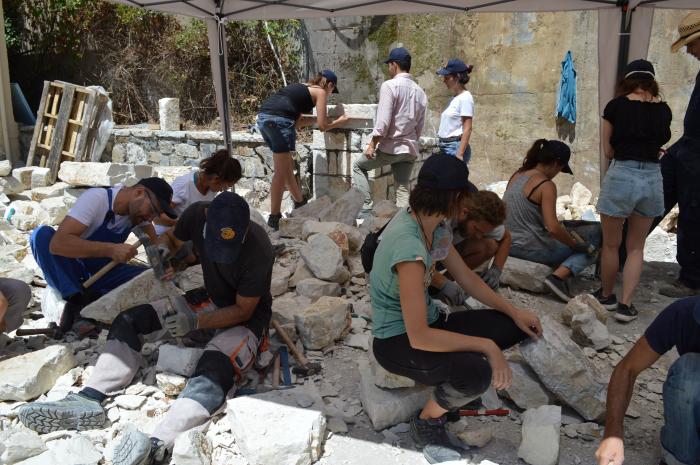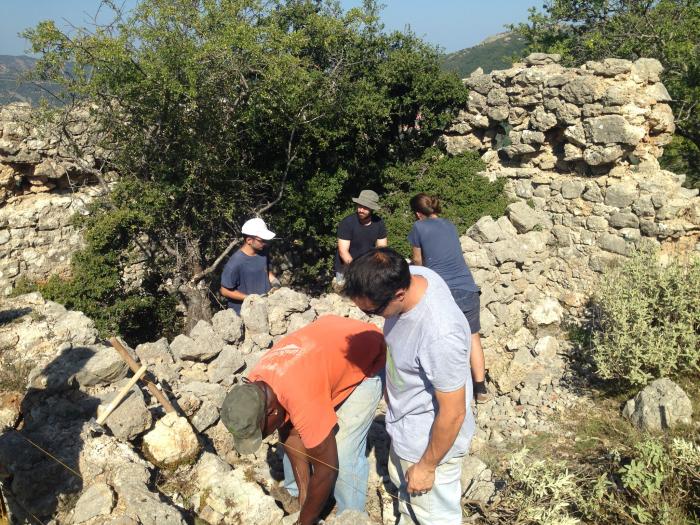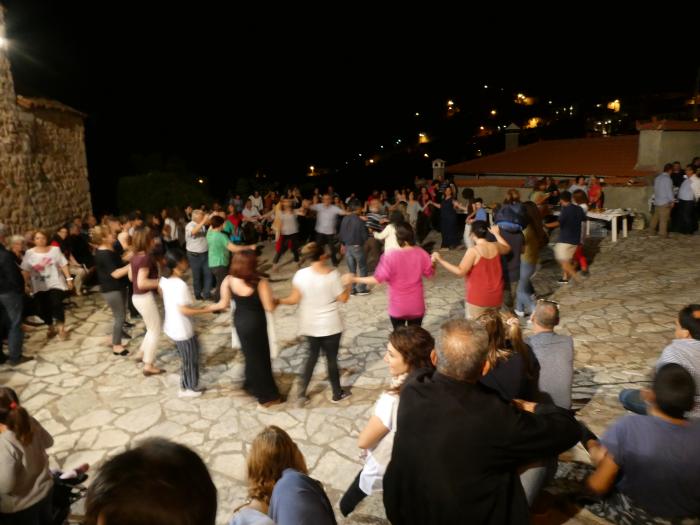I. SUMMARY INFORMATION
Project
269029
Status
Submitted
Award category
Preserved and transformed cultural heritage
You want to submit
NEW EUROPEAN BAUHAUS AWARDS : existing completed examples
Project title
FESTIVITIES OF THE STONES as Re-Culture
Full project title
FESTIVITIES OF THE STONES: Regenerating Stonemasonry-Preserving Heritage-Fostering Culture
Description
“Festivities of the Stones” is a unique concept project, designed and developed by Blossoming Stones, a local citizen movement, based in Lagadia, Arcadia-Greece. It includes a broad array of cultural initiatives, centered upon the regeneration of local traditional stonemasonry and the preservation of local cultural heritage. Activities ran from 2017 to 2019, culminating each summer in a two weeks’ event, engaging the local community, expatriates, and friends sharing its aims and aspirations.
Where was your project implemented in the EU?
Greece
Peloponesse, Arcadia
Lagadia, Arcadia
37.682890
22.031050
Lagadia
22003
When was your project implemented?
Has your project benefited from EU programmes or funds?
No
Which programme(s) or fund(s)? Provide the name of the programme(s)/fund(s), the strand/action line as relevant and the year.
II. DESCRIPTION OF THE PROJECT
Please provide a summary of your project
’Blossoming Stones’ is a local citizens movement, established in 2013. ‘Festivities of the Stones’ is a project formulated so as to run continuously from 2017 to 2019, incorporating select and carefully organized activities that evolve around the transmission of traditional knowledge, empowering the memory of the local community. The project evolved around the following:
Three on site, yearly rolling hands-on workshops of vocational training on traditional stonemasonry, with the active and extended participation of local citizens, experienced stonemasons, students, local enterprises, as well as the local authorities. These workshops aimed in strategically reactivating traditional stonemasonry, a characteristic monoculture of Lagadia settlement and still a basic trait of local identity, followed by tangible results in the form of delivering for public use, fully restored infrastructure: a stone threshing floor, a fountain, and a cobblestone path,
Three lecture series, supplemented by the parallel organization of student and professional seminars that engage the local community, many descendants of old masons, enabling the training on the preservation of local cultural heritage in traditional settlements and rural territories in the broader Peloponnese, and mobilizing the participation of a multi-disciplinary array of academics (architects, historians, ethnographers, archaeologists, cultural geographers, etc.),
Three festivals, culminating and celebrating the workshop accomplishments and uniting the local people, fostering their social cohesion and empowering their local pride.
The experience gathered from the project and because of the motivation stirred up, the ‘Blossoming Stones’ have successfully managed to register the local traditional stonemasonry in the Greek national inventory of intangible heritage and to acquire, through crowdfunding, a traditional building to be transformed into a traditional stonemasonry center and host a vocational training center
Please give information about the key objectives of your project in terms of sustainability and how these have been met
‘Festivities of the Stones’ were conceived, designed, organized and operated mainly on a voluntary basis, depending solely on contributions by members and friends, and especially through the participation of local – in Lagadia, Arcadia – citizens, authorities and enterprises. The sustainability of the project has been so far largely enabled by the growing interest and active participation of the board members, the scientific council, and the registered members of ‘Blossoming Stones’, also supported by an extensive network of friends and affiliate organizations of the initiative, largely involved in the actual events.
The sustainability of the project was based upon the sustainability of its activities. Local heritage protection is an upcycling activity that re-uses local resources, minimizes energy footprint, makes sustainable use of local and natural materials and engages traditional knowledge that secures a sustainable model of ecological building that protects both the cultural heritage as well as the surrounding natural environment. Sustainability is also secured by employing young professionals, activating related and complemental professions, and, finally, by encouraging activities and enterprises focusing on environmental and cultural tourism. This leverage of both repairing and restoring traditional settlements and rural space at large is considered as a major policy for upgrading public space, also implanting cyclic economy best practices and paradigms.
Finally, sustainability has been depicted through the project by means of strengthening local, social and cultural cohesion, especially in the citizen communities that have strategically decided to remain in the specific geographic areas, devoted to a more rural and less urbanized way of life. These communities are not only allowed and expected to participate in the project’s events and trainings, but rather most of the activities are driven by them, for them, thus guaranteeing a strong sense of inclusion.
Please give information about the key objectives of your project in terms of aesthetics and quality of experience beyond functionality and how these have been met
‘Festivities of the Stones’ is also including repairs and restoration work on traditional buildings and structures in the public space of traditional settlements, as well as in other widespread rural heritage dry-stone structures (retaining walls, threshing floors, rural fountains, mule trails, cobblestone paths, watermills, rural chapels, shrines, etc.) These activities focus on reviving public buildings and public space, beautifying it, and improving the quality of life for the citizens of these areas, in terms of both cultural preservation and citizen participation experience. Public space is re-imbued with local history and memory and heritage preservation withholds local identity, establishing a balanced equilibrium with the surrounding natural environment. In addition, any interference made in the physical environment and structures is strictly following the aesthetics of the respective traditional works, both in look-and-feel, as well as in the methodologies and practices adopted for our approach to delivering results that naturally blend into existing works, as well as in the environment where they reside.
Furthermore, the settlement of Lagadia has been selected as the historical and contemporary basis for organizing the activities of ‘Festivities of the Stones’, being long registered in Greece as an “entopic” place, a good place to live in, invoking a deep sense of local belonging, ensuring social and cultural cohesiveness for the population and, also, for sharing local pride, dominant through the centuries not only to the local residents but also internationally, touching the pastoral works depicting Arcadia. In this sense, the project carries not only aspects of functionality, but also encompasses a complete participation experience, placing senses as the driving force of the process, and promoting the feeling of belonging.
Please give information about the key objectives of your project in terms of inclusion and how these have been met
All the activities in the ‘Festivities of the Stones’ are based on the voluntary participation and active engagement of members, friends, local citizens and enterprises, and associate groups. Starting from the inclusive intergenerational activities of the traditional stonemasonry workshops, it expands in concentric cycles of engaging more and more people that complement its core activities. The active participation of all members of the local society forms the reason for the existence of the society and the basic prerequisite for the success of its diverse cultural activities. Based on an all-inclusive local bonding, the invitation to participate is extended to neighboring villages, connected through family relations and congenial built environments, created by the same stonemasons. This concentric model of participation enables the activation and contribution of everyone, according to their capabilities and time availability.
In this context, inclusion for everybody also establishes a renowned paradigm of social motivation and participation, tampering with both the individual, as well as other local entities that may participate in the endeavor: Local authorities, businesses, and unions, geographically nearby communities, etc. This has been a key objective for Blossoming Stones, it is clearly stated in its manifest and is a requirement included in every single event or activity designed and implemented. In this way, our objectives for inclusion clearly met, especially in the yearly manifestation events. What we have witnessed in the past years, includes:
- A yearly increasing number of participants (members, friends, educational institutions, students, stonemasons, local authorities, local enterprises, etc.),
- A significant rise of awareness in the local communities and growth in their urge to participate, and
- A parallel leverage of other activities, such as cultural tourism, naturally blending and complementing the core tasks being implemented.
Please give information on the results/impacts achieved by your project in relation to the category you apply for
Individuals attending the local workshops have been actively involved in exemplary repairs and restorations of public buildings, refurbishing public space in Lagadia and nearby areas, and reviving old cobblestone paths, threshing floors, retaining walls in the rural and natural surroundings.
In addition, educational activities and extensive documentation have been carried out, retrieving old contracts, interviewing master masons, collecting and producing audiovisual content on traditional stonemasonry, retrieving old family photos that document various aspects of the craft. This documentation work has been indispensable in the implementation of the cultural heritage restoration projects, constituting by itself an act of preserving intangible heritage. With respect to intangible heritage, in particular, the project has facilitated the preparation of the complete portfolio for the nomination of the traditional heritage of stonemasonry as one of the eighteen intangible heritage entries in the natural inventory of intangible heritage, held by the Greek Ministry of Culture.
Due to its holistic nature, the project not only constitutes a best practice of devising and implementing an orchestrated scheme towards integrating cultural heritage preservation but also touches upon all the other categories of the NEB. Traditional heritage, tangible and intangible, almost by definition and by necessity: Uses local materials and techniques (cat. 1), is built in the spirit of the cyclic economy as an immediate response to needs and just implementing a policy (cat. 2), provides viable solutions for the balanced coexistence between built places and natural environment (cat. 3), regenerates public space of traditional settlements in unison with the rural territory (category 4), contributes to the quality of everyday life since traditional setting are not monuments to visit but ensembles to live in (categories 5-7), and instigates the mobilization of local communities (category 8).
Please explain the way citizens benefiting from or affected by the project and civil society have been involved in the project and what has been the impact of this involvement on the project
The active participation and involvement of citizens in the ‘Festivities of the Stones’ has been an indispensable part of the project, even from the early design phase. This active involvement, especially from citizens of the local, or, nearby civil societies, aimed in a mutually beneficial approach, that would both issue a proof of their affection and engagement to causes that actively affect their quality of life, with major parallel economic impact, as well as facilitate the successful execution of the project activities.
Under this view, citizen participation secured the following:
Social cohesion. Citizens from the local communities actively participated in the project, completed their tasks with a renowned feeling of belonging and continuity, especially since the project proclaimed and successfully demonstrated that a high level of quality of life can be maintained in the local areas, securing and preserving traditional crafts as an integral part of both the intangible heritage, as well as an actual, continuously applied craft.
Economy growth. Benefits out of this project range from immediate economic opportunities for the local participants, ranging from the employment of local young professionals that can be active in repairs and restoring projects, to active contribution and shaping of their public life and wellbeing. The impact of this project is manifested by the ‘willingness to pay', expressed in the successful crowdfunding initiative that attracted many people with considerable contributions in a period of economic crisis.
Project success. The project could not have been implemented and successfully completed without the active, vivid, enthusiastic, and multi-faceted assistance received by the participating volunteers of the local communities, and the decisive support from the local authorities and enterprises that shared this common vision.
Please highlight the innovative character of the project
The basic aim of ‘Festivities of the Stones’ started by targeting the most basic features of local culture, and grew in time by developing in concentric cycles, encompassing all other aspects of local culture in a cohesive, inclusive, gradual engagement of people towards a lasting interest and involvement. All activities are orchestrated around the revival of traditional stonemasonry as the foundation upon which preservation of cultural heritage and its transformation into a common contemporary good can be accomplished.
The innovative character of the project lies in the enlargement and expansion process it managed to build, literally and metaphorically, founded upon previous activities, thus employing the character of a culture that has to endure and sustain its goals and its diversity objectives, achieving convergence in its goals. The discrete activities of the ‘Festivities of the Stones’ function as a culture within a culture of re-activating heritage in contemporary life.
All activities are designed to build upon previous accomplishments and aim at developing them further. Traditional Stonemasonry, far from a nostalgic cling to the past, attempts to reinvigorate the rich, local tradition towards its transformation into a driver of contemporary development. The next development goal of priority is the creation of a Traditional Stonemasonry Centre, based in Lagadia, Arcadia, to be followed by a vocational training school for local young professionals, drawing on the skills and expertise of still surviving old master masons. Traditional crafts are transferred to younger generations to the delight of old masters and the benefit of new apprentices. This local vocational training of new masons to work throughout the Peloponnese in heritage restoration and repair projects could develop as a new, flourishing economic sector.
Please explain how the project led to results or learnings which could be transferred to other interested parties
‘Festivities of the Stones’ included a significant, and irreplaceable research phase, consisting mainly of detailed architectural documentation of existing structures (measured drawings, research on written sources, such as building contracts, structured interviews with the last remaining master builders, archival research in visual material and family records, oral history narratives, etc.), that highlight local cultural life, centered upon stonemasonry as the main occupation of the inhabitants and the cultural hub where all family lives and communal life converge.
This documentation process enables the proper execution of the necessary repair and restoration studies, preserving, at the same time, the intangible heritage that is elicited out of the dominant local craft. This extensive documentation facilitated the organization of local workshops, comprising of in situ demonstrations of building techniques by the master masons, of on-site guided practices. These were accompanied by theoretical seminars on cultural heritage preservation, enhancement, and management approach, along with special seminars on materials and building techniques, offered by a balanced team of multi-disciplinary academics and craftsmen.
The learning examples acquired through this process have been carefully organized in a way that facilitates their dissemination and successful transfer to other interested parties:
How to successfully transmit traditional stonemasonry to young professionals and – through parallel workshops – to other craftsmen, engineers, and architects.
Showcase an example of how to re-activate a traditional craft and engage the local community. This kind of learning apart from showcasing a result of good practice also showcases the specific methodologies to design and implement similar projects.
Is an evaluation report or any relevant independent evaluation source available?
No
III. UPLOAD PICTURES
IV. VALIDATION
By ticking this box, you declare that all the information provided in this form is factually correct, that the proposed project has not been proposed for the Awards more than once under the same category and that it has not been subject to any type of investigation, which could lead to a financial correction because of irregularities or fraud.
Yes





